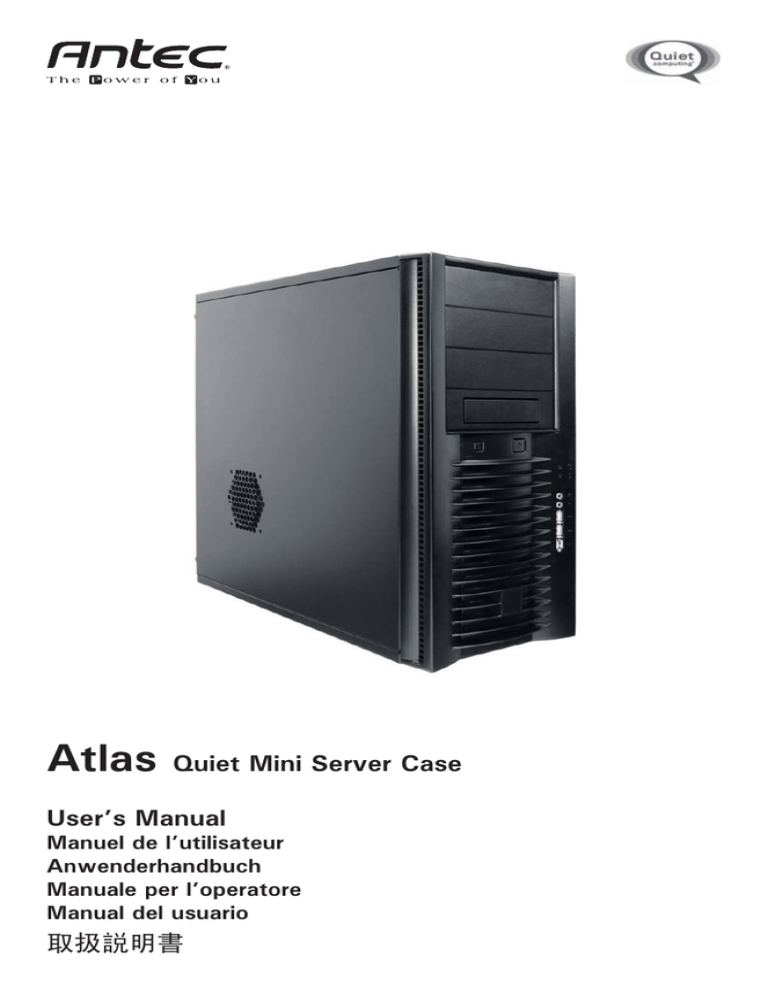
Atlas
Quiet Mini Server Case
User’s Manual
Manuel de l’utilisateur
Anwenderhandbuch
Manuale per l’operatore
Manual del usuario
পᡅ䂀ᯢ
1
At Antec, we continually refine and improve our products to ensure the highest
quality. So it’s possible that your new case may differ slightly from the descriptions in this manual. This isn’t a problem; it’s simply an improvement. As of the
date of publication, all features, descriptions, and illustrations in this manual are
correct.
Disclaimer
This manual is intended only as a guide for Antec’s Computer Enclosures.
For more comprehensive instructions on installing the motherboard and peripherals,
please refer to the user’s manuals which come with the components and drives.
Atlas User’s Manual
Atlas – Quiet Mini Server Case
This case comes with a 550 Watt EPS12V power supply. Turn the switch to the
ON ( I ) position before you boot up the computer for the first time. Normally, you
won’t need to switch to the OFF (O) position, since the power supply includes a
soft on/off feature which lets you turn the computer on and off by using the soft
switch on the computer case. If the computer crashes and you can’t shut it down
using the soft switch, you can switch the main power to the OFF (O) position to
clear the fault, then reboot.
Only for models designed for sale in the European Union:
Antec power supply models feature Power Factor Correction (PFC) circuitry in
accordance with European standard regulation code EN61000-3-2. By altering the
input current wave shape, PFC improves the power factor of the power supply.
This results in increased energy efficiency, reduced heat loss, prolonged life for
power distribution and consumption equipment, and improved output voltage stability. Together with the high efficiency design and the quiet 80mm fan, the power
supply delivers a cleaner and quieter operating environment.
Setting Up
1. Place the case upright on a flat, stable surface.
2. Note (not applicable to models designed for the European Union): Before installation, check the red voltage switch setting on the power supply. It should
match your local voltage (115V for North America, Japan, etc. and 230V for
Europe and many other countries). If it doesn’t match, please change the setting. If you don’t you could damage your equipment and void your warranty.
3. Loosen the thumbscrews from the right side panel. Remove it by swinging it
out. Note: Don’t use your fingernails to pry or lift the panels.
4. Inside the case you should see the power supply, some wiring with marked
connectors (USB, PWR etc.), and installed I/O panel, a power cord and a plastic
bag containing more hardware (screws, brass standoffs, plastic stands, etc.),
and six drive rails.
5. There are three plastic tabs on the left side of the bezel. They fasten the front
bezel to the metal chassis. Release the tabs from the top down to release the
bezel.
1
6. Swing the bezel open to about 45º and gently lift the bezel up. The front bezel
will come off easily. Set the bezel aside in a safe place
Installing the Motherboard
This manual does not cover CPU, RAM, or expansion card installation.
Please consult the motherboard manual for specific mounting instructions and
troubleshooting.
1. Lay the case down, with the open side facing up. The drive cages and power
supply should be visible.
2. Make sure you have the correct I/O panel for the motherboard. If the panel
provided with the case isn’t suitable, please contact the motherboard manufacturer for the correct I/O panel.
3. Line up the motherboard with the standoff holes, and remember which holes
are lined up. Not all motherboards will match with all the provided holes; this is
normal, and won’t affect functionality.
4. Remove the motherboard.
5. Screw the brass standoffs into the threaded holes that line up with the motherboard. Do not overtighten the standoffs. Some standoffs may be pre-installed
for your convenience.
6. Place the motherboard on the brass standoffs.
7. Screw in the motherboard to the standoffs with the provided Philips-head
screws. The motherboard is now installed.
Connecting the Power and LED
This case has an Antec TruePower 2.0 (TP2-550EPS12V) power supply which is
EPS12V compatible and comes with a configurable 24-pin Main Power Connector,
an 8-pin +12V, and a 4-pin +12V Power Connector for the motherboard. It also
includes four SATA connectors, five to seven 4-pin peripheral power connectors,
one to two 4-pin Floppy Drive power connectors, and one PCI Express graphic
card power connector.
Picture 1
Picture 2
1. Connect the 24-pin Main Power Connector and the
4-pin +12V or 8-pin +12V connector to your motherboard as needed. If your motherboard uses a 20-pin
For 24-pin
For 20-pin
connector, detach the 4-pin attachment on the 24-pin
motherboards
motherboards
power connector (see pictures 1 and 2). Connect the
peripheral power connectors to devices such as hard
drives, optical drives, etc.
2. Connect the Reset switch (labeled RESET SW) to the motherboard at the RST
connector. Make sure the label always faces the front of the case.
3. Power LED (labeled POWER LED) connector is located behind the Reset connector.
4. Power Switch (labeled POWER SW) connects to the PWR connector on the
motherboard.
5. Hard Drive LED (labeled H.D.D. LED) connects to the IDE connector.
Connecting the USB Ports
You will find a single 10-pin connector on a cable attached to the front USB ports.
This is an Intel standard connector, which is keyed so that it can’t be accidentally,
reversed when connected to a proper Intel standard motherboard header. Connect
the 10-pin connector to the motherboard headers so that the blocked pin fits over
the missing header pin.
2
Note: Please check the motherboard manual for the USB header pin layout and
make sure it matches the attached table. If it does not match this Intel standard,
please call Antec customer service at (800) 22ANTEC (North America) or
+31 (0) 10462-2060 Europe) to buy a USB adapter. This adapter will allow you
to connect the front USB to the motherboard on a pin-by-pin basis.
Motherboard Pin Layout
1
2
9 10
Pin
Signal Names
Pin
Signal Names
1
USB Power 1
2
USB Power 2
3
Negative Signal 1
4
Negative Signal 2
5
Positive Signal 1
6
Positive Signal 2
7
Ground 1
8
Ground 2
9
Key (No Connection)
10
Empty Pin
Connecting the IEEE 1394 (FireWire®, i.Link®) Port
You will find a single 10-pin connector on a cable attached to the front IEEE 1394
connection. This is an Intel standard connector, which is keyed so that it can’t
be accidentally reversed when connected to a proper Intel standard motherboard
header. Connect the 10-pin connector to the motherboard header so that the
blocked pin fits over the missing header pin.
Note: Please check the motherboard manual for your IEEE 1394 header pin layout
and make sure it matches the attached table. If you intend to connect the front
FireWire port to an IEEE 1394 add-on card that comes with an external-type
IEEE 1394 connector, please call Antec customer service at (800) 22ANTEC
(North America) or +31 (0) 10 462-2060 (Europe) to buy an adapter. This adapter
will allow you to connect the front IEEE 1394 port to the external-type connector.
Pin Assignment for Front Panel IEEE 1394 Connector
1
2
9 10
Pin
Signal Names
Pin
2
Signal Names
1
TPA+
3
Ground
4
Ground
5
TPB+
6
TPB–
7
+12V (Fused)
9
Key (No Pin)
3
8
10
TPA–
+12V (Fused)
Ground
Connecting the Audio Ports
There is an Intel standard 10-pin connector (that has 7 individual wires with connectors) leading to the front panel speaker and microphone connection. If the
motherboard supports Intel’s standard onboard audio connector, you can plug the
10-pin connector directly onto the board. For non-Intel standard audio connection,
you will need to plug the 7 individual connectors to the motherboard. See the following instructions:
Locate the internal audio connectors from the motherboard or sound card. Consult
the motherboard or sound card manual for the pin-out positions.
1.
2.
3.
4.
5.
6.
7.
Microphone Signal Pin: Connect the MIC connector to this pin.
Microphone Power: Connect the MIC-BIAS connector to this pin.
Ground Pin: Connect the AUD GND connector to this pin.
Front Right Speaker Out Pin: Connect the FPOUT-R connector to this pin.
Front Left Speaker Out Pin: Connect the FPOUT-L connector to this pin.
Rear Right Speaker Out Pin: Connect the RET-R connector to this pin.
Rear Left Speaker Out Pin: Connect RET-L connector to this pin.
Hard Disk Installation
There is a hard disk cage right under the external 5.25” drive. You can mount
four hard drives using the trays inside it.
1. Open the front bezel as described in Setting Up section.
2. Loosen the two thumbscrews. Swing open the fan cage and gently lift the
cage upward to remove it. You will see four drive trays with soft silicon grommets inside the cage.
3. Squeeze the metal clips on each side of the tray and slide the tray out.
4. Mount your hard drive into the drive tray through the bottom rubber grommets
with the special screws provided. Note: Don’t over-tighten the screws.
Over-tightening the screws will reduce the vibration and noise-dampening ability of the rubber grommets.
5. Slide and lock the tray back into the case.
6. Find a 4-pin molex connector on the power supply and connect it to the male
4-pin connector on the device.
7. Repeat the same procedure for the other devices as necessary.
8. Put the front fan cage back to the case. If you plan to mount the optional
92mm case fans, do it now. See The Cooling section for fan installation.
5.25” Device Installation
There are four external 5.25” drive bays (one with 5.25” to 3.5” Adapter).
Carefully remove the metal plate covering the drive bay.
1. Take two plastic drive rails and mount them to the sides of the 5.25” device.
Make sure to use the front set of the screw holes on the drive rail. Also make
sure the end of the drive rail is angled away from the device and facing forward.
2. Slide the device into the drive bay until you hear a click.
3. Mount the other devices accordingly.
4. Connect a large 4-pin connector from the power supply to the male 4-pin connector on each of the devices.
4
To
1.
2.
3.
install a floppy or other external 3.5” device to the 5.25” to 3.5” Adapter:
Slide the Adapter out.
Place the drive to the adapter and fasten the drive with screws provided.
Find a 4-pin floppy power connector on the power supply and connect it to the
male 4-pin connector on the devices.
Cooling System
The TriCool™ fan:
The case includes one 120mm TriCool™ fan installed in the rear. This fan has a
three-speed switch that lets you choose between quiet, performance, or maximum
cooling. (See specifications below.) The fan is installed so that the air is blowing
out of the case. Connect a large 4-pin connector from the power supply to the
male 4-pin connector on the fan.
Note: The minimum voltage to start the fan is 5V. We recommend that our users
set the fan speed to High if you choose to connect the fan to a fan control device
or to the Fan-Only connector found on some of Antec’s power supplies. A fancontrol-device regulates the fan speed by varying the voltage to it. The voltage
may start as low as 4.5V to 5V. Connecting a TriCool™ set on Medium or Low
to a fan-control device may result in the fan not being able to start. The already
lowered voltage from the fan control device will be further reduced by the TriCool™
circuitry below 5V.
Specifications:
Size:
Rated Voltage:
Operating Voltage:
Speed
Input
Current
120mm x 120mm x 25.4mm
DC 12V
10.2V ~ 13.8V
Air Flow
Static
Pressure
Acoustical
Noise
Input
Power
High
2000 RPM
0.24A
(Max.)
2.24 m³ / min
(79 CFM)
2.54 mm-H2O
(0.10 inch-H2O)
30 dBA
2.9 W
Medium
1600 RPM
0.2A
1.59 m³ / min
(56 CFM)
1.53 mm-H2O
(0.06 inch-H2O)
28 dBA
2.4 W
Low
1200 RPM
0.13A
1.1 m³ / min
(39 CFM)
0.92 mm-H2O
(0.04 inch-H2O)
25 dBA
1.6 W
The Front 92mm fans
You can install two 92mm fans to the fan cage in front of the internal 3.5”
drives. These fans must be installed so that the air is blowing into the case. We
recommend using Antec 92mm TriCool™ fans to balance quiet performance with
maximum cooling. See our web site for product information. Note: Please choose
your fan speed wisely. In most cases, a medium or even low speed setting will be
enough to supply adequate cooling.
5
Antec, Inc.
47900 Fremont Blvd.
Fremont, CA 94538
US
tel: 510-770-1200
fax: 510-770-1288
Antec Europe B.V.
Sydneystraat 33
3047 BP Rotterdam
The Netherlands
tel: +31 (0) 10 462-2060
fax: +31 (0) 10 437-1752
Customer Support:
US & Canada
1-800-22ANTEC
customersupport@antec.com
Europe
+31 (0) 10 462-2060
europe.techsupport@antec.com
www.antec.com
© Copyright 2006Antec, Inc. All rights reserved.
All trademarks are the property of their respective owners.
Reproduction in whole or in part without written permission is prohibited.
Printed in China.
Version 1.0.1 01/26/2006
38






